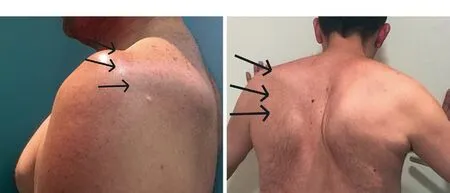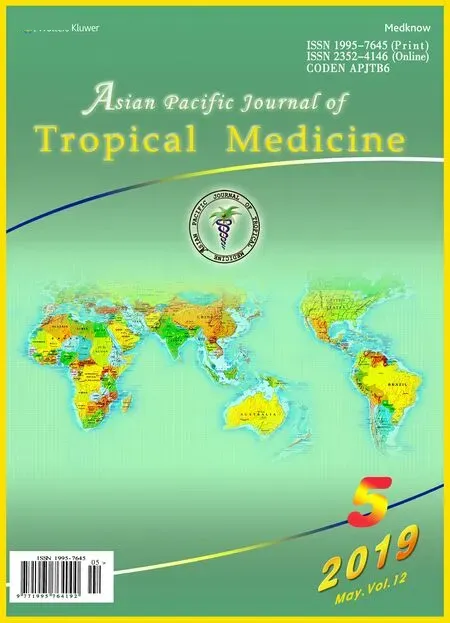Parsonage-Turner syndrome following chikungunya virus infection:A case report
Luis Arthur Brasil Gadelha Farias, Marina Vasconcelos Sampaio, Antônio Carlos Delgado Sampaio, Roberto da Justa Pires Neto, Jorge Luiz Nobre Rodrigues
1School of Medicine, Federal University of Ceará, Fortaleza, Ceará, Brazil
2School of Medicine, Universitary Center Christus (Unichristus), Fortaleza, Ceará, Brazil
3Orthopedic Department, São Carlos Hospital, Fortaleza, Ceará, Brazil
4Hospital São José de Doenças Infecciosas, Fortaleza, Ceará, Brazil
5Infectology Service, Walter Cantídeo University Hospital, Fortaleza, Ceará, Brazil
Keywords:Parsonage-Turner syndrome Chikungunya virus Chikungunya fever Brachial amyotrophy Case report
ABSTRACT Rationale: Parsonage-Turner syndrome is a rare syndrome of unknown etiology, affecting mainly the lower motor neurons of the brachial plexus. Chikungunya fever is a mosquito-borne viral disease characterized by acute fever and polyarthritis/polyarthralgia.Patient concerns: A 54-year-old Brazilian male patient who presented with a 2-day history of fever (temperature 38.8 ℃), arthralgia, erythematous rash, diffuse osteomuscular pain and headache, which evolved into left shoulder pain associated with morning stiffness.Diagnosis: Parsonage-Turner syndrome and chikungunya fever.Interventions: Symptomatic treatment (a combination of short-acting dypirone (500 mg every 6 h) and slow-release opioids (tramadol 100 mg every 4 h) and physiotherapy/rehabilitation with improvement.Outcomes: The patient was improved and discharged, remaining with symptomatic treatment and physiotherapy/rehabilitation.Lessons: To the best of our knowledge, there were no reports of Parsonage-Turner syndrome following chikungunya virus infection. Awareness of the possibility of this rare association is important. The present case report highlights the importance of awareness of this association as a new cause of morbidity in patients with chikungunya virus infection.
1. Introduction
Parsonage-Turner syndrome (PTS), also known as neuralgic amyotrophy and brachial plexitis, is an idiopathic disease characterized by the clinical triad of pain, muscle atrophy, and sensory symptoms. The etiology of the syndrome is unclear, but it is reported in a myriad of clinical situations such as trauma, surgery,autoimmune disease, malignant tumors, vaccination, and infection.Parsonage M.J. and Turner J.W.A. first described the syndrome in 1948[1]. Doctors rarely attribute an etiology to the syndrome because usually management is symptomatic and does not modify the evolution of the syndrome[1]. There are no cases of PTS following chikungunya virus (CHIKV) infection in the literature, although other viral, bacterial and parasitic conditions may be related to the syndrome. Chikungunya fever is a mosquito-borne viral disease characterized by acute fever and polyarthritis/polyarthralgia.The virus was first locally transmitted in Brazil in September 2014[2]. Atypical manifestations due to CHIKV infection, such as cardiovascular and neurological impairment, have been described,but other systems such as renal, gastrointestinal, and ocular can also be affected. The total range of chikungunya fever related symptoms is still unknown[2-4].
In the present report, we describe a case of a 54-year-old Brazilian male patient who presented with PTS following CHIKV infection confirmed by positive immunoglobulin M (IgM) according to Macenzyme-linked immunosorbent assay (ELISA).
The study was conducted after ethical approval from the Research Ethics Committee of Hospital São José de Doenças Infecciosas(protocol number 2.405.527). Patient’s oral consent has been obtained.
2. Case report
A 54-year-old male patient from Ceará state located in Northeastern Brazil was admitted presenting with a 2-day history of fever (temperature 38.8 ℃), arthralgia, erythematous rash, diffuse osteomuscular pain and headache, which evolved to left shoulder pain associated with morning stiffness and not relenting with common analgesics. Blood and white cell count were in the normal range. Platelet count 110 000/μL (normal: 130 000/μL-400 000/ μL).Liver and renal functions were normal. NS1 protein and dengue immunoglobulin M (IgM) and immunoglobulin G (IgG) serology were negative. But chikungunya IgM serology was positive. Anti-HIV 1 and 2, CMV IgM/ IgG and Toxoplasma serology were negative.He had no history of recent travel and denied any ophthalmologic symptoms such as conjunctivitis. Symptomatic treatment was started with a combination of short-acting dypirone (500 mg every 6 h) and slow-release opioids (tramadol 100 mg every 4 h) with improvement.One month later, the left shoulder pain persisted with a history of multiple visits to the emergency room for opioid analgesia. On physical examination, reduction of elevation, abduction, and external rotation of the left shoulder were observed, and progressive atrophy of the shoulder girdle musculature was noted (Figure 1A and 1B).Neurological examination did not indicate any further deficits. MRI of the shoulder revealed acute/subacute involvement of the brachial plexus and the supra and infraspinatus muscles, which is compatible with PTS (Figure 2). The patient was improved and discharged with symptomatic treatment and physiotherapy/rehabilitation.
3. Discussion

Figure 1. A 54-year-old male patient with Parsonage-Turner syndrome. A: Scapular winging and atrophy on coronal plan. B: Scapular winging and atrophy of the supraspinatus muscle. Black arrows show the atrophy.
The suggested current incidence of PTS is 1‰; however, there are no studies evaluating its incidence rates in Brazil. Other studies estimate the global incidence to be 2-3 per 100 000, revealing the under-recognition of this disease possibly due to difficulty in diagnosis[5]. The etiopathogenesis remains unknown but it is believed that an immune reaction after a previous infection may be the cause[1]. The most common virus involved is the hepatitis E virus, which has been reported in 10% of patients with PTS[6].Although hepatitis E serology was not available in our center, it is important to exercise an index of suspicion, particularly in travelers to the Amazon basin, Bahia state in the North-eastern region and the southeast[7]. Although CHIKV infection is characterized in severe cases by acute myelitis, meningoencephalitis, and Guillain-Barré syndrome, to the best of our knowledge, there are no case reports that manifest any association between CHIKV and PTS[3,4].Other viruses implicated are varicella-zoster virus, Epstein-Barr virus, parvovirus B19 and cytomegalovirus[1,6]. Although CHIKV share the same vector with ZIKA virus (ZIKAV) and dengue virus(DENV), CHIKV is part of the Togaviridae family, while DENV and ZIKAV are parts of the Flaviviridae family which makes the cross-reaction between these viruses complicated. Kam et al. found that 6% of DENV-infected patients had antibodies that were crossreactive to CHIKV[8]. The authors recognize the absence of RTPCR detection for ZIKAV as a limitation to our study, but we believe that the clinical findings do not match with the common ZIKAV manifestations.

Figure 2. A 54-year-old male patient with Parsonage-Turner syndrome following chikungunya virus infection. A-C: Black arrows show edema/denervation of the supraspinatus and infraspinatus muscles with atrophy. D: Black arrows reveal glenohumeral joint effusion with slight joint thickening.
Diagnosis of PTS is usually made clinically. The main symptom is a severe acute shoulder pain with no apparent cause, and profound weakness[1,5,6]. The differential diagnosis is diverse and includes rotator cuff abnormalities such as calcific tendinitis, adhesive capsulitis, cervical radiculopathy, spinal cord tumor, acute infection,and traumatic disorders of the shoulder[1]. Invasive tests or imaging are reserved for less clear or doubtful cases. Nevertheless, an MRI of the shoulder does on occasion reveal no abnormalities. Sneag et al.[9]demonstrated that 24 of 27 cases presented with a clinical picture in which the plexus proper appeared normal in signal and morphology in MRI studies. It is believed that PTS can affect extraplexal nerves instead of any portion of the brachial plexus. As demonstrated by this case, the direct signs in MRI are long segment enlargement of one or more portions of the plexus, increased T2 signal intensity,and perineural edema. Other indirect signs may present as muscle denervation edema or fatty atrophy of muscle[9].
The prognosis is good [1,5,6]. Treatment is supportive with analgesia and rest to reduce pain during activity, mainly in the early stages.During the recovery period, physiotherapy is recommended. In the acute phase, corticosteroids may also be helpful in selected cases.The optimal treatment for PTS is unclear and there is a lack of evidence of the efficacy of therapeutic measures. Some case reports present the use of intravenous immunoglobulin therapy based on studies reporting an association between the immune response and PTS, which can be a useful tool in the later stages[10]. Further studies are necessary to clarify the efficacy of current therapy and the effects of chronic CHIKV infection in PTS.
4. Conclusion
To the best of our knowledge, this is the first reported case of PTS following CHIKV infection. During the earliest stages, pain management with opiates may be necessary. The mainstay of treatment at this stage is opioids, NSAIDS, and neuroleptics. We emphasize the importance of recognizing the possible association between PTS and CHIKV, as another morbidity factor that could be caused by the virus. More studies are necessary to understand the pathophysiological mechanism and etiological relation between these conditions. In the absence of an established etiology, other more serious causes, such as autoimmune and malignant disorders,should be excluded. The differentiation diagnosis process should be guided by the patient history and epidemiology of the disease.
Conflict of interest statement
The authors declare that they have no competing interests.
Acknowledgements
The authors would like to acknowledge the patient and his family for the valuable support during this research.
 Asian Pacific Journal of Tropical Medicine2019年5期
Asian Pacific Journal of Tropical Medicine2019年5期
- Asian Pacific Journal of Tropical Medicine的其它文章
- Seroprevalence of Cryptosporidium and risks of cryptosporidiosis in residents of Sothern Egypt: A cross-sectional study
- Evaluation of phytochemical properties and larvicidal activities of Cynodon dactylon, Clerodendrum viscosum, Spilanthes acmella and Terminalia chebula against Aedes aegypti
- Phylogeny of Culex theileri virus flavivirus in Spain, Myanmar, Portugal and Turkey
- Climate change and potential distribution of zoonotic cutaneous leishmaniasis in Central Iran: Horizon 2030 and 2050
- Antimalarial activity of a novel series of artemisinin-derived 1, 2,3-triazole dimers
